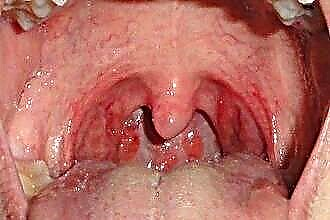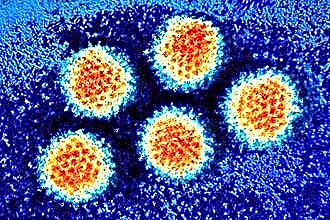Baking soda (sodium bicarbonate) is a fine powder with alkalizing properties. In informal medicine, it is used as an effective anti-inflammatory, disinfecting and drying agent. Irrigation of the nasopharynx with a soda solution accelerates the process of separating mucus and restoring normal microflora in the ENT organs.
 Systematic rinsing of the nose with soda is indicated for rhinitis, sinusitis, adenoids and other colds. Alkalizing therapy helps to suppress the activity of pathogens in the foci of inflammation, which leads to regression of catarrhal processes.
Systematic rinsing of the nose with soda is indicated for rhinitis, sinusitis, adenoids and other colds. Alkalizing therapy helps to suppress the activity of pathogens in the foci of inflammation, which leads to regression of catarrhal processes.
Inhalation and irrigation of the nasopharynx are the most effective means of local therapy, with the help of which it is possible to stop the manifestations of acute and chronic rhinitis in adults and children. Sodium bicarbonate promotes gentle cleansing of the nasopharynx from mucous accumulations, which greatly facilitates nasal breathing. A decrease in pressure in the paranasal sinuses, provoked by the accumulation of viscous secretions, leads to a decrease in headaches.
Operating principle
Can I rinse my nose with baking soda for a cold? The powder has pronounced antiphlogistic, decongestant and wound healing properties. For this reason, experts recommend using soda solutions to treat inflammation in the mucous membranes of the nose and oropharynx. What is the reason for the effectiveness of sodium bicarbonate?
Baking soda is an effective neutralizer of the metabolites of pathogenic agents in the affected tissues.
It promotes the degassing of toxic substances in the foci of inflammation, which stimulates the strengthening of local immunity. Alkalization therapy allows you to restore the acid-base balance in the body, which affects the reactivity and ability of the immune system to resist disease-causing viruses and bacteria.
When sodium bicarbonate dissociates, the level of alkali in the blood rises, which helps to strengthen the immune system. The alkaline environment is unfavorable for the development of aerobic and anaerobic pathogens, as a result of which their number decreases. The elimination of the pathogenic flora accelerates the regression of inflammation and the restoration of the integrity of the affected tissues.
Medicinal properties
 Treatment of colds in the early stages of development helps prevent serious inflammation of the nasopharynx. Prompt elimination of pathogenic agents prevents their penetration into the paranasal sinuses, which prevents the development of sinusitis, rhinorrhea, bacterial rhinitis, etc. Soda for the common cold is a simple and affordable remedy with which you can eliminate local manifestations of the common cold within a few days.
Treatment of colds in the early stages of development helps prevent serious inflammation of the nasopharynx. Prompt elimination of pathogenic agents prevents their penetration into the paranasal sinuses, which prevents the development of sinusitis, rhinorrhea, bacterial rhinitis, etc. Soda for the common cold is a simple and affordable remedy with which you can eliminate local manifestations of the common cold within a few days.
Soda solution is one of the effective antiseptic agents with a pronounced alkalizing effect. It is often used to treat metabolic acidosis caused by a violation of the acid-base balance in the body. The use of fine-crystalline powder for inhalation and rinsing contributes to:
- reducing swelling in the nasal passages;
- cleansing the paranasal sinuses from purulent exudate;
- evacuation of viscous mucus from the nasal passages;
- elimination of discomfort in the nasopharynx;
- destruction of pathogenic viruses and microbes;
- disinfection and healing of injuries on the mucous membranes of the ENT organs.
Important! Experts do not recommend using soda solution to treat atrophic rhinitis.
Indications for use
Can I rinse my nose with baking soda? Irrigation of the nasopharynx with a weak solution of sodium bicarbonate improves the patient's condition literally after 3-4 procedures. However, experts warn that you should consult your doctor before using the product. Hypersensitivity of the mucous membrane can cause an allergic reaction, leading to an increase in swelling in the tissues.
According to experts, alkalizing therapy can be used to treat diseases such as:
- flu;
- ethmoiditis;
- rhinorrhea;
- adenoids;
- sinusitis;
- acute rhinitis;
- laryngotracheitis;
- chronic rhinitis.
Important! Steam inhalation should not be carried out with the development of a bacterial rhinitis or sinusitis.
Timely passage of local therapy allows you to restore the balance in the acid-base balance. Thus, local and general immunity is strengthened, which contributes to the speedy elimination of pathogens in the ciliated epithelium.
Flushing
Nasal lavage is an effective therapeutic procedure during which pathological secretions with pathogenic viruses, bacteria and fungi are eliminated from the nasopharynx. Irrigation of the nasal cavity with a soda solution helps to reduce the viscosity of the liquid secretion, as a result of which its evacuation is accelerated. Regular lavage of the nasopharynx allows you to eliminate local manifestations of rhinitis within 3-4 days.
It is undesirable to rinse the nose for children under 5 years old, which is due to the risk of fluid penetration into the Eustachian tube and lungs.
How should i rinse my nose with baking soda? To irrigate the nasopharynx, you need to do the following:
- dissolve in 250 ml of boiled water ¼ tsp. sodium bicarbonate;
- heat the solution to 36-37 degrees;
- fill up the liquid in a rubber syringe;
- tilting your head, inject the solution into the upper nostril;
- after 15 seconds, blow out the accumulated mucus;
- clean the other nostril in the same way.
With the development of a cold, you need to perform at least 3-4 procedures per day for a week. To enhance the disinfecting effect of the solution, you can add a couple of drops of iodine to it.
Sinusitis treatment
It is possible to stop the symptoms of sinusitis with the help of a soda-salt solution, which has a pronounced anti-inflammatory, analgesic and decongestant effect. Salt helps to "pull" purulent exudate from the maxillary sinuses, thereby accelerating the healing process. How should you rinse your nose with salt and baking soda?
To achieve the desired therapeutic effect, the following nuances must be taken into account during the lavage of the nasopharynx:
- dissolve ½ teaspoon of soda and salt in 300 ml of boiled water;
- warm the liquid to room temperature;
- rinse your nose with a syringe or syringe without a needle;
- perform the procedure at least 4 times a day.
It is not recommended to eat and drink within 30 minutes after the procedure.
No less effective will be a soda solution with propolis tincture. To prepare the product, dissolve 1 tsp of sodium bicarbonate in 250 ml of boiled water and add 15 drops of tincture. The finished solution should be used to rinse the nose at least 3 times a day.
Inhalation
Inhalation is an effective way of administering a drug directly to the site of inflammation. Inhalation of gaseous substances with an anti-inflammatory effect accelerates the regression of catarrhal processes not only in the nasal passages, but also in the pharynx. Reducing the time of absorption of sodium bicarbonate into the nasopharyngeal mucosa accelerates the destruction of pathogens.
Inhalation with a runny nose with soda can be carried out only in the absence of cardiac arrhythmias and bullous emphysema of the lungs. In case of hyperemia, experts recommend replacing steam inhalations with inhalation of aerosols through a nebulizer. In the absence of a device, it is advisable to replace inhalation procedures with irrigation.
When undergoing therapy, vapors of the heated solution should be inhaled through the nose. To speed up the evacuation of mucus from the nasal passages, you can add a few drops of peppermint or juniper essential oil to the liquid. According to patients and doctors, immediately after inhalation, relief occurs due to a decrease in pressure in the paranasal sinuses.
Instructions
How should inhalation be carried out with a runny nose with soda? Failure to comply with the basic rules of inhalation can cause burns in the nasopharyngeal mucosa. That is why, when treating preschool children, pediatricians recommend using nebulizers as an inhaler. Easy-to-use instruments convert the medicinal solution into an aerosol rather than hot steam.
To avoid complications, during the procedure, you should pay attention to the following points:
- to prepare a medicinal solution, dissolve 1 tbsp in 1 liter of boiling water. soda;
- you can enhance the bactericidal effect of the solution by adding 3 cloves of chopped garlic to it;
- when inhaling, hot steam must be inhaled through the nose, alternately closing each nostril;
- the duration of one procedure should not exceed 10 minutes.
To prevent the development of sinusitis and other post-infectious complications, inhalations should be performed at least 2 times a day for 5 days.
Contraindications
Alkalizing therapy is one of the most effective methods for relieving the clinical manifestations of rhinitis. However, experts warn that the use of sodium bicarbonate can lead to the development of complications. To prevent a deterioration in well-being, do not use soda solutions for inhalation and irrigation of the nasopharynx when:
- kidney failure;
- hyperthyroidism;
- hypersensitivity of the skin;
- pulmonary bleeding;
- heart failure.
The advisability of using baking soda for therapeutic purposes should be consulted with a doctor.



